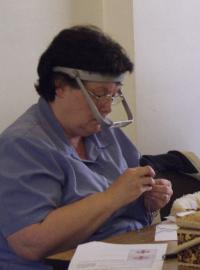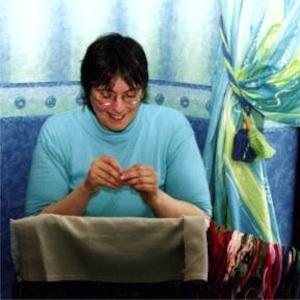- Home
- What do I need?
Embroidery supplies and equipment
To enjoy needlework, you need the right embroidery supplies and equipment and somewhere to keep them together.
Here are the tools and materials I can't live without in my sewing box. Check out the links below for more information...
Want to take a stroll down memory lane? Check out this list of must-haves from a British schoolgirl in 1930. They used pre-decimal pounds, shillings, and pence back then. Don't worry, the link opens in a new window so you won't lose this page.
Embroidery Scissors
You need sharp embroidery scissors.
I'm always shocked by the scissors students bring to my class. Dressmaking shears? Kitchen scissors? Blunt scissors that chew thread? Get yourself a small, sharp pair with pointed blades that cut well.
This is especially important if you're trying Hardanger or other cutwork techniques. Suggest scissors as a gift idea for family and friends who ask.
Read more about embroidery scissors here.
Traditional Embroidery frames
If you're not into hoops, there are lots of scroll frames to choose from. They're traditionally for needlepoint, but they work great for embroidery too. They've got wooden rollers on top and bottom with webbing strips attached, and side pieces that stretch the fabric. You can get them in different sizes.
You need bars wider than your fabric. The length of the side pieces doesn't matter because you'll wind the excess fabric around the top and bottom bars.
Use strong thread to tack your fabric to each webbing strip. Wind the extra fabric around one or both bars so you can reach where you're stitching.
Counted thread work usually starts in the center, so wind an equal amount onto both bars. You can also lace the fabric edges to the side bars to keep it under tension.
Slate frames work great for keeping fabric tight while stitching. Fit your design inside the frame because you pin down the fabric and can't roll it around bars.
Apparently they're called slate frames because they used to be used for school slates. If the slate broke, they'd use the frame for needlework instead of throwing it away.
Modern Embroidery Frames
Modern frames eliminate the need for stitching your fabric to webbing. They have slots in the top and bottom bars. The fabric goes over the slots and a wooden dowel holds it tight.
Another type has 4 plastic tubes that snap together at the corners. The fabric goes over the tubes and snap-on covers keep it in place.
No matter what hoop or frame you use, loosen the work after stitching to avoid stretching the fabric too much.
Lap Frame
Holding a hoop or frame can tire your non-stitching hand.
Use a lap frame or floor stand to support the frame and have two hands to stitch with.
Lap frames come in two types: one with a fixed hoop or frame and another with a clamp for any size hoop or frame. This makes the work easier and faster.
Floor stand
I often use a sturdy wooden or metal floor stand for stitching.
Some stands have spots to attach accessories like lamps, magnifiers, chart holders, or magnets. The magnet is great for keeping your threaded embroidery needles in place for later use.
An excellent stand will last for years without needing to be replaced. If it looks nice, you can leave it out as furniture in between stitching sessions.
Lighting
I love illumination. I have three lamps for sewing. They let me stitch anytime, anywhere without picking up the wrong colored embroidery thread.. If we meet, ask me about the foxes!
I've got a big lamp on my desk with a daylight bulb. It's perfect for shining light on my needlework. When I don't want to bother my husband while he's watching TV or when I'm out of the house, I use a small lamp that clips onto my hoop.
My favourite is the lamp magnifier with a fluorescent tube and magnifying glass. These are perfect if you always stitch in one room. But it's heavy, so I don’t carry it around.
This affiliate link will take you to Amazon where you can choose from a wide variety of craft lamps.
Magnifier

As I get older, a magnifier is handy for my embroidery work.
Many of my students use a magnifying glass that hangs around the neck (affiliate link) and has little "feet" that stand on their chest. Some also have a light.
I tried them, but they didn't work for me. I kept losing focus on the fabric when I moved, and the magnifier kept slipping, so I had to keep adjusting it. They might work for you though, and they're economical.
I like my magnifier up close. There are a few ways to do this. Clip-on magnifiers for glasses work. But I prefer Mag Eyes.
As you can see in the picture, this headband magnifier sits comfortably on your forehead, keeping them at an ideal distance from your eyes. Hinged arms enable you to push the lenses up out of the way when you don't need them.
Don't make my mistake. If you wear these, don't do what I did. I pushed them back after stitching and forgot they were on. Then, while shopping, I couldn't figure out why people were staring at me weirdly.
Is your workbox ready?
To complete your embroidery supplies, keep a tape measure or ruler and dressmaking shears nearby for measuring and cutting fabric. If you use embroidery floss and beads, have a storage system to keep them organized.
Embroidery is a beautiful and intricate art that requires the right tools.
Before you start, there are a few things to think about, like picking the right fabric and needles, and using frames or stands for support. Don't forget to have good lighting and magnification so you can see what you're doing. With these tips in mind and all the supplies at your fingertips, you'll be able to create stunning embroidery pieces that show off your artistic skills and technical know-how.
Stay connected between projects
If you’d like occasional updates from my embroidery room, including new patterns, gentle tips, and little things I think you might enjoy, you’re warmly invited to join the Stitchin’ Times newsletter.
No pressure. Just a friendly note now and then to keep you inspired.








